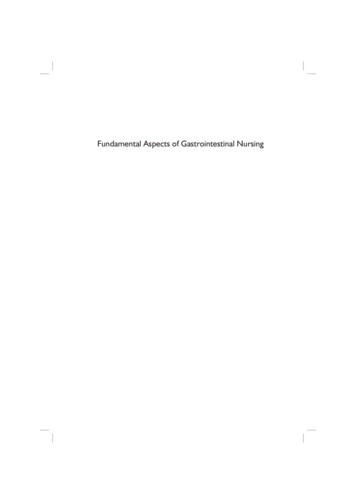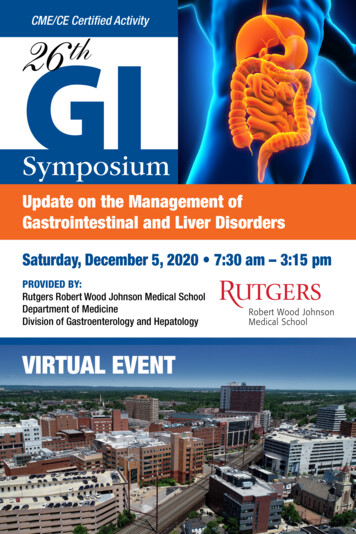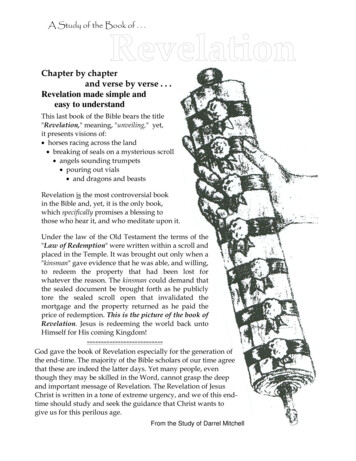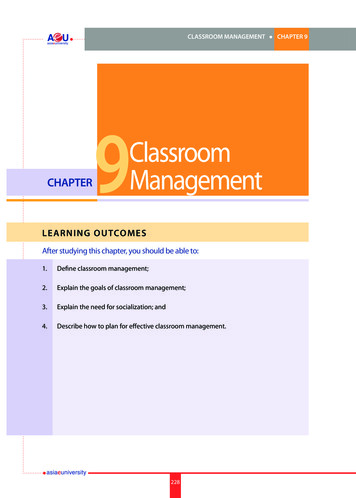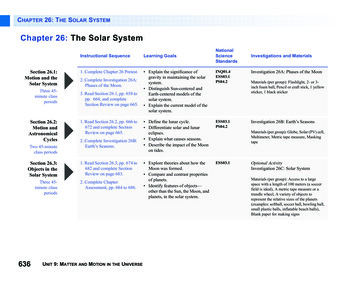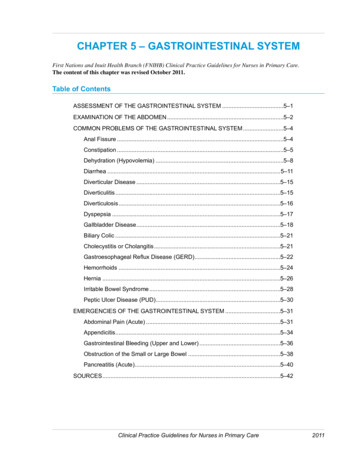
Transcription
CHAPTER 5 – GASTROINTESTINAL SYSTEMFirst Nations and Inuit Health Branch (FNIHB) Clinical Practice Guidelines for Nurses in Primary Care.The content of this chapter was revised October 2011.Table of ContentsASSESSMENT OF THE GASTROINTESTINAL SYSTEM.5–1EXAMINATION OF THE ABDOMEN.5–2COMMON PROBLEMS OF THE GASTROINTESTINAL SYSTEM.5–4Anal Fissure.5–4Constipation.5–5Dehydration (Hypovolemia).5–8Diarrhea.5–11Diverticular 5–16Dyspepsia.5–17Gallbladder Disease.5–18Biliary Colic.5–21Cholecystitis or Cholangitis.5–21Gastroesophageal Reflux Disease ble Bowel Syndrome.5–28Peptic Ulcer Disease (PUD).5–30EMERGENCIES OF THE GASTROINTESTINAL SYSTEM.5–31Abdominal Pain (Acute).5–31Appendicitis.5–34Gastrointestinal Bleeding (Upper and Lower).5–36Obstruction of the Small or Large Bowel.5–38Pancreatitis (Acute).5–40SOURCES.5–42Clinical Practice Guidelines for Nurses in Primary Care2011
Gastrointestinal System5–1ASSESSMENT OF THE GASTROINTESTINAL SYSTEMThe following characteristics of each symptomshould be elicited and nset (sudden or gradual)ChronologyCurrent situation (improving or deteriorating)LocationRadiationQualityTiming (frequency, duration, pattern)SeverityPrecipitating and aggravating factorsRelieving factorsAssociated symptomsEffects on daily activitiesPrevious diagnosis of similar episodesPrevious treatmentsEfficacy of previous treatmentsJaundice–– History of acute hepatitis (Viral – A,B,C,Epstein-Barr, alcohol/drug induced)–– History of chronic liver diseases–– Scleral icterus–– Yellow skin tones–– Tea-coloured urine–– Clay-coloured bowel movements–– Itchy skinDysphagia––––––––––Solids or liquidsSite where food gets stuckFood is regurgitatedFood/medication intake historySensation that food is stuck, but improveswith eatingCARDINAL SYMPTOMSOther Associated SymptomsIn addition to the general characteristics outlinedabove, additional characteristics of specific symptomsshould be elicited, as Abdominal PainAsk about all of the characteristics (see “Assessmentof the Gastrointestinal System”).Nausea and Vomiting–– Frequency, amount–– Presence of bile–– Presence of blood and its colour (for example,bright red, dark, colour of coffee grounds)FeverMalaiseHeadacheDry skinDehydrationDry mouthDiet recall, appetite and foods avoided (includingreasons for avoidance)–– Meal pattern (for example, small, frequent meals)–– Anorexia–– Recent weight loss or gain that is not deliberateMEDICAL HISTORYGastrointestinal:Bowel Habits–– Usual and changes in the frequency, colour,consistency of stool–– Changes in the diameter of stool–– Presence of blood or melena–– Pain before, during or after defecation–– Sense of incomplete emptying after bowelmovement–– Tenesmus–– Use of laxatives–– History of hemorrhoids, anal fissure–– Belching, bloating and flatulence–– Esophageal disease (gastroesophageal refluxdisease [GERD], Barrett’s esophagus, toxic injury)–– Gastric/duodenal disease (gastric ulcers, diabeticgastroparesis, hiatus hernia, peptic ulcer disease)–– Gallbladder disease (biliary colic, cholelithiasis,choledocholithiasis, cholecystitis)–– Liver disease (hepatitis, chronic diseases, cirrhosis)–– Pancreatic disease (pancreatitis)–– Small/large bowel disease (inflammatorybowel disease, ischemic colitis, diverticulosis/diverticulitis, polyps, history of bleeding)–– Functional bowel problems (irritable bowelsyndrome [IBS], constipation, previous obstruction)Clinical Practice Guidelines for Nurses in Primary Care2011
estinal SystemRectal/anal disease (anal fissure, proctitis)Presence of hernia, massesBlood transfusionAbdominal neoplasmAbdominal surgeryPast and current use of medications, supplements,herbs (for example, nonsteroidal anti-inflammatories,estrogen, progesterone, calcium channel blockers,anticholinergics, antacids, antibiotics, thiazidediuretics, steroids, digoxin, azathioprine)Nongastrointestinal considerations (may causegastrointestinal illness/symptoms):–– Cardiovascular disease (myocardial infarction,congestive heart failure, vasculitis, hypertension)–– Renal disease (polycystic kidneys)–– Gynecologic conditions (pregnancy, endometriosis,ovarian cysts)FAMILY HISTORY (SPECIFIC TOGASTROINTESTINAL SYSTEM)–– Alcoholism–– Any history related to the gastrointestinalsystem (see “Medical History”)–– Household contact with gastroenteritis, foodpoisoning–– Metabolic disease (for example, diabetes mellitus,porphyria)–– Cardiac disease–– Renal diseasePERSONAL AND SOCIAL HISTORY (SPECIFICTO GASTROINTESTINAL ��–––––––––––––Alcohol useSmokingCaffeine intakeUse of street drugs, including injection drugsUse of anabolic steroidsTravel to area where infectious gastrointestinalconditions are endemicBody piercing or tattoosStress at work, home or schoolDietary intake of nitrates (for example,smoked foods)Diet (including wild game)ObesityIntake of untreated waterSanitation problems at home or in the communitySexual practicesOCCUPATIONAL OR SCHOOL ENVIRONMENT–– Health care occupation–– Institutional environment – workers or residents(for example, nursing home)–– Environmental exposure–– Chemical exposureEXAMINATION OF THE ABDOMEN–– Apparent state of health–– Appearance of comfort or distress–– Preferred position of comfort (supine, sittingforward, lying on side)–– Colour (for example, flushed, pale, jaundiced)–– Nutritional status (obese or emaciated)–– State of hydration (skin turgor)–– Match between appearance and stated ageVITAL SIGNS–– Temperature and pulse–– Respiratory rate–– Blood pressure2011ABDOMINAL INSPECTION–– Abdominal contour, symmetry, scars, dilatationof veins–– Movement of abdominal wall with respiration–– Visible masses, hernias, pulsations, peristalsisAUSCULTATIONAuscultation should be performed before percussionand palpation so as not to alter bowel sounds.–– Presence, character and frequency of bowel sounds–– Presence of bruits (renal, iliac or abdominal aortic)Clinical Practice Guidelines for Nurses in Primary Care
Gastrointestinal SystemPERCUSSION–– Percuss from resonant to dull areas–– Liver: define upper and lower borders, measurespan (normal: 6–12 cm in the mid-clavicular line)–– Spleen: confirm presence of normal resonanceover lowest rib interspace in anterior axillary line–– Bladder: identify distention and fullness–– Identify other areas of dullness, increasedresonance or tenderness–– Assess for ballotment if suspect ascitesLIGHT PALPATION–– Tenderness, muscle guarding, rigidity–– Superficial organs or massesDEEP PALPATION–– Tender areas, rebound tenderness–– Liver: size, tenderness, whether edge is smoothor irregular, firm or hard–– Spleen: enlargement, tenderness, consistency–– Kidney: tenderness, enlargement, tendernessof ostovertebral angle–– Masses: location, size, shape, mobility, tenderness,movement with respiration, pulsation, hernias(midline, incisional, groin)–– Inguinal lymph nodes: enlargement, tenderness–– Femoral pulsesABDOMINAL EXAMINATION:PERIPHERAL AREAS–– Jaundice (scleral icterus, skin)–– Spider nevi on face, neck or upper trunk–– Palmar erythema, Dupuytren’s contracture(both associated with chronic liver disease)–– Clubbing of fingers (late sign associated withinflammatory bowel disease, cancer)RECTAL EXAMINATION–– For occult blood (which would indicategastrointestinal [GI] bleeding)–– For referred pain (which occurs in appendicitis)–– For masses, hemorrhoids, anal fissures, sphinctertone, etc.–– Prostate exam in males (size, consistency,tenderness)5–3CARDIOVASCULAR ANDPULMONARY EXAMINATIONA cardiovascular and pulmonary exam should alsobe performed.–– Heart sounds–– Lungs (crackles, bronchial breath sounds inlower lobes)–– Peripheral pulses (may be altered or asymmetricwith aortic aneurysm)–– In shock, vital signs and capillary refill maybe altered–– Abdominal pain (may be referred from the lungsin pneumonia, heart in myocardial infarction)Considerations for the Elderly–– Classic symptom patterns for disease are notreliable with older adults due to decreased painperception, comorbid conditions and reduced organfunction due to the aging process–– Tend to present later in the course of the illness–– Symptoms may be nonspecific and/or poorlylocalized, complicating differential diagnosis–– More likely to have cognitive deficits and/or alterations in mentation at presentation,complicating assessment and diagnosis–– Delirium and confusion common with constipation,inadequate hydration, anemia secondary togastrointestinal blood loss–– May have absence of fever, even with seriousinfection–– Have decreased pain perception so may not haveclassic presentation of an acute abdomen–– At higher risk for certain conditions andcomplications to conditions due to the agingprocess (cardiovascular disorders [abdominalaortic aneurysm, mesentary ischemic disease],gallbladder disease, bowel obstruction, peptic ulcerdisease, constipation)–– Consider prostate screening in males 50 bydigital rectal exam (DRE) and/or prostate specificantigen (PSA) test1Clinical Practice Guidelines for Nurses in Primary Care2011
5–4Gastrointestinal SystemCOMMON PROBLEMS OF THE GASTROINTESTINAL SYSTEMANAL FISSURE2,3,4Painful, linear tear in anal mucosa.CAUSES–– Chronic constipation–– Trauma to anal canal (from hard stool, analintercourse, foreign object)–– Complication of Crohn’s disease, ulcerative colitis,HIV/AIDS, syphilis, leukemia, tuberculosis, cancerOnce an anal tear occurs, a pattern of repeat injuryoccurs from anal sphincter spasm that retracts thewound edges impairing healing and repeat injurywith defecation which may lead to a chronic fissure.Suspect an underlying etiology for the fissure whenthe wound does not respond to therapy.–– Sexually transmitted infections(HIV/AIDS, syphilis)–– Ano-rectal malignancy–– Tuberculosis–– Leukemia–– ProctitisCOMPLICATIONS–– Constipation–– Chronic anal fissure–– Secondary sphincter spasm and painDIAGNOSTIC TESTS–– NoneMANAGEMENTHISTORYGoals of Treatment–– Acute pain during and after defecation (painmay be severe, often described as “tearing”)–– Pain may persist for several hours post-defecation–– Spotting of bright red blood with defecation–– Bleeding tends to be minimal (often only seenon toilet paper after wiping)–– Perianal itching or irritation–– Constipation caused by fear of pain–– Tends to occur in young and middle-aged adults–– Most common cause of chronic perianal pain––––––––––PHYSICAL FINDINGSTo examine anal area, have client lie on left sidewith the knees drawn up to the chest. Firmly retractbuttocks to adequately visualize anal tissues.–– Overlying anal mucosa may conceal hemorrhoid–– Acute fissure appears like a fresh laceration–– Swelling, skin tag, fibrosis or sphincter musclevisualized at wound base (chronic fissure)–– Usually one fissure, at posterior midline (suspectother underlying diagnosis if not midline orif multiple)–– Digital rectal exam causes acute painDIFFERENTIAL DIAGNOSIS–– Thrombosed external hemorrhoids–– Perianal or perirectal abscess–– Inflammatory bowel disease (Crohn’s disease,ulcerative colitis)2011Relieve pain, sphincter spasmPromote healingRelieve underlying constipationPrevent recurrencePrevent stricture formationNonpharmacologic Interventions–– Most acute fissures are superficial and willheal spontaneously over 4–6 weeks–– Sitz baths 3 or 4 times daily for 20 minuteswith warm salt waterClient Education–– Instruct client about proper perianal hygieneand prevention of infection–– Counsel client about lifestyle and diet(increase dietary fibre, fluids, exercise)Pharmacologic InterventionsReduction of Local Pain and DiscomfortLocal topical preparations without corticosteroidsmay be useful:zinc sulfate ointment (Anusol), bid and after eachbowel movementAn ointment is better than a sup
(for example, nursing home) – Environmental exposure – Chemical exposure. EXAMINATION OF THE ABDOMEN – Apparent state of health – Appearance of comfort or distress – Preferred position of comfort (supine, sitting forward, lying on side) – Colour (for example, flushed, pale, jaundiced) – Nutritional status (obese or emaciated) – State of hydration (skin turgor) – Match between
